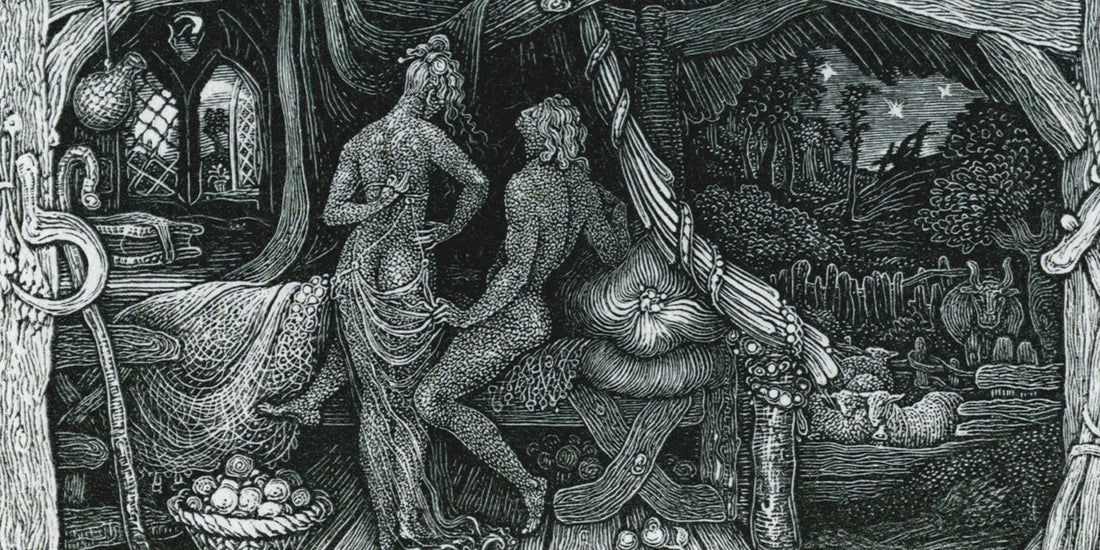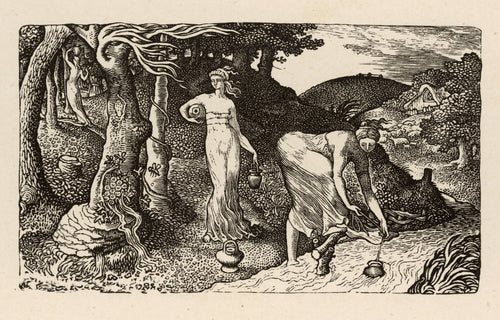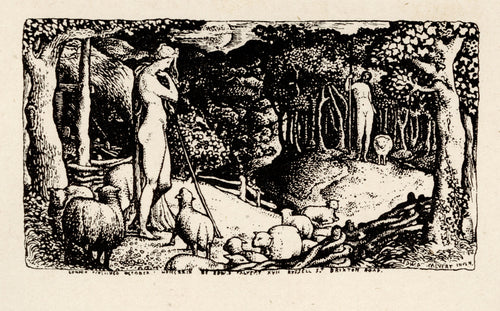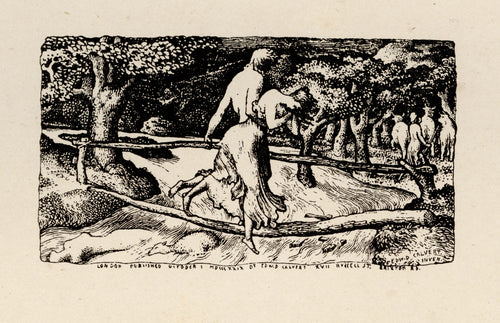Three years ago we received our first set of exquisite miniature engravings by Edward Calvert; nearly all of them sold within a few weeks of our publicising them.
In 2016, we managed to acquire a second set, though this time from the 'Carfax' portfolio, a rare edition that was limited to a mere 30 copies. Extremely few exist outside of museum collections and have been described by Calvert expert Raymond Lister as virtually unobtainable.
These prints are unbelievably scarce, and it is unlikely that we will ever acquire this set again.
To accompany such a once-in-a-lifetime purchase, we reissued an updated version of our original article on Calvert's engravings with new, higher definition images. Many of these prints measure no more than 10cm or so across; that they can be reproduced here at such enlarged sizes without loss of definition must say something about the incredible skill that went into their creation.
 The Gem
The Gem
When William Blake died in 1827, Britain lost the most revolutionary artistic figure it had ever seen. To the ‘Ancients’, a group of visionary artists who centred around Blake, his death meant the loss of a tutor and idol. The profound influence of Blake’s work did not die with him, however, and for one such Ancient - the young Edward Calvert - his death would galvanise an already proficient artist into a period of unparalleled conception and expression.
 'The Return Home' - small but beautiful at just 7.5cm x 4cm
'The Return Home' - small but beautiful at just 7.5cm x 4cm
Calvert, born in 1799, began life with a brief stint in the Navy before the death of a close friend during a bombardment of Algiers prompted him to leave and follow a less promising career as a painter and printmaker. Early technical encouragement came by way of the Royal Academy, where Calvert was admitted in 1825, but it was a subsequent friendship with the younger Samuel Palmer who would introduce Calvert to Blake and his mystic circle of companions that proved instrumental to his artistic development.
 'an ardent religious appreciation for Nature and the earth' - 'The Lady and the Rooks'
'an ardent religious appreciation for Nature and the earth' - 'The Lady and the Rooks'
Time spent with the Ancients was illuminating, their meetings in Palmer’s cottage - ‘Rat Alley’, as it was affectionately known - involving discussions of poetry, printing technique and deeper spiritual musings. The elder Blake, whom Palmer described as their prophet, impressed upon Calvert and the group an ardent religious appreciation for Nature and the earth, as well as instructing the young artist in the process of wood-engraving and the visionary artistic style.
 'imagery redolent of classical pastoral scenes and Christian parables' - 'The Brook'
'imagery redolent of classical pastoral scenes and Christian parables' - 'The Brook'
Calvert’s work after Blake’s death immediately matured, as if the loss of such an inspirational figure had spurred him on to greater heights. The period that followed from 1827 to 1831 is universally considered to have been Calvert’s pinnacle, comprising wood and copper engravings and lithographs all characterised by fine, dextrous lines depicting sylvan vistas - imagery redolent of both classical pastoral scenes and symbolic Christian parables.
 'the stray lamb; the classical figure of the nude' - Blake's visionary influence shines through in 'The Bride'
'the stray lamb; the classical figure of the nude' - Blake's visionary influence shines through in 'The Bride'
Viewed alongside the work of his mentor, Calvert’s engravings possess a naive confidence that was typical of the Ancients’ work, and the influence of Blake cannot be ignored. We can see in prints like ‘The Bride’ the same symbolism at work: the Christian allegory of the stray lamb; the classical figure of the nude.
 'exquisite smallness' - detail from 'The Chamber Idyll', which stands 4cm tall and 7.5cm across
'exquisite smallness' - detail from 'The Chamber Idyll', which stands 4cm tall and 7.5cm across
But it is an influence that belies the exquisite smallness and intricacy of Calvert’s work that is essentially his own, wherein lies both his uniqueness and his significance. ‘The Chamber Idyll’, Calvert’s magnum opus, is as near a perfect example of miniature art as has perhaps ever been produced.
 'a period of unparalleled conception and expression' - 'The Cyder Feast'
'a period of unparalleled conception and expression' - 'The Cyder Feast'
It is surprising, then, that the first ever publication of such prints came posthumously. Calvert was a supremely self-critical artist: those works that survived his own periodic purges represent the very best of his output, and in his lifetime were only viewed by contemporaries and friends. Ten years after his death, however, Samuel Calvert, Edward’s third son, published his Memoir in 1893 with an edition size of 350.
 'virtually unobtainable'; Calvert's prints are as scarce as they are magical - 'The Sheep of his Pasture'
'virtually unobtainable'; Calvert's prints are as scarce as they are magical - 'The Sheep of his Pasture'
A later portfolio, from which these prints are taken, was also printed by the Carfax Gallery in 1904 in a minute edition size of a mere 30 copies. With a far smaller edition run, greater attention was given to the treatment of the blocks; the resulting impressions are far sharper than those from the Memoir and extremely few copies are to be found outside of museum collections.
 details from the two extraordinarily rare original lithographs from the Carfax portfolio
details from the two extraordinarily rare original lithographs from the Carfax portfolio
Of particular scarcity are the two lithographic prints in the portfolio: while those in the Memoir were machine printed from process blocks and reduced in size, the clearer Carfax pair were taken from the original edition of 30, the only state of this lithograph that was made and whose printing was supervised by Calvert himself. As the expert Raymond Lister noted in his monograph on the artist, such prints are extraordinarily rare, with impressions from these earlier states being virtually unobtainable.
 'beside their Christian mysticism stirred an enchantment with rustic ideals' - 'The Ploughman'
'beside their Christian mysticism stirred an enchantment with rustic ideals' - 'The Ploughman'
Calvert’s engravings embody in miniature form the Romanticism of his fellow visionaries. Like Palmer and Blake, he was deeply and devotedly spiritual; but beside their Christian mysticism stirred an enchantment with rustic classical ideals, with countryside idylls and Nature’s pagan beauty. That such power can be felt from so delicate images as these is testament to Calvert’s immense skill in the carving of his blocks. The resulting prints are enigmatic, intimate and of real importance to the history of British art.



